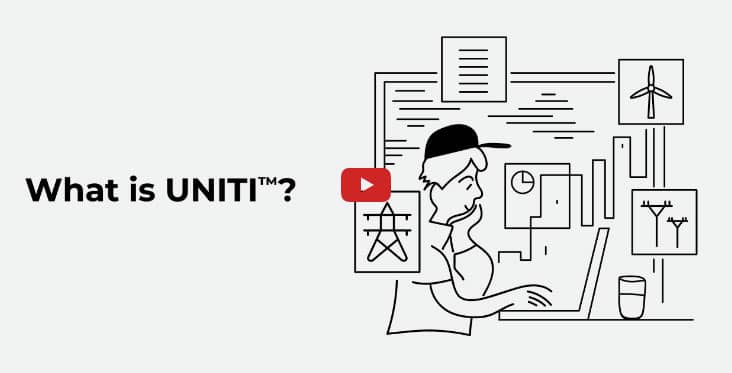Maintaining grid health is central to the successful operation of any modern electric utility, yet, in many organizations, we continue to see evidence of poor cohesion between field operations and central management. Oftentimes this can prevent timely interventions.
Centralized asset management systems, including UNITI Workspace, are making life easier by enabling real-time collaboration across teams and geographies. By aggregating data into actionable insights and eliminating redundancies, these systems enhance both decision-making precision and operational efficiency. This blog explores how real-time collaboration is transforming grid health management.
The Role of Centralized Asset Management Systems
Centralized asset management platforms enable utilities to address these inefficiencies by consolidating their data streams and workflows. For example, UNITI employs an asset-centric architecture, anchoring all data—inspection reports, geospatial tags, historical maintenance records—to individual transmission components like towers, lines, or substations.
This ensures that field teams, engineers, and managers access the same up-to-date information, reducing inconsistencies and improving coordination.
One key feature is the automated ingestion of georeferenced data from sources such as drones, IoT sensors, and SCADA systems. This eliminates manual data entry, a common bottleneck. For instance, a California utility used UNITI to process drone-captured images from wildfire-damaged transmission lines. Automated tagging reduced imagery sorting time by 75%, expediting repair scheduling.
Furthermore, UNITI integrates seamlessly with existing software ecosystems, such as GIS databases and work order management systems (WOMS), through secure APIs. This interoperability facilitates event-based triggers, such as issuing maintenance alerts when asset health metrics fall below a predefined threshold.
By enabling such automation, utilities can significantly reduce the lag between issue detection and resolution.
Real-Time Collaboration in Practice
The benefits of real-time collaboration through centralized platforms are particularly evident in field operations. For example, during a major winter storm in the Midwest in 2024, a utility using UNITI Workspace enabled its field teams to synchronize inspections and repairs remotely.
Crews with mobile devices accessed live updates, including annotated images and severity assessments. They were able to focus on more urgent repairs and restore power 30% faster than in previous storms..
Another advantage is the ability to conduct condition-based inspections rather than adhering to rigid, time-based schedules. Centralized platforms aggregate sensor data to identify assets requiring immediate attention, such as a transmission line experiencing thermal overload. Field teams receive these insights in real-time, which allows for more targeted inspections.
The International Energy Agency (IEA) emphasizes the increasing importance of digital technologies, such as condition-based monitoring, in boosting energy system efficiency and heightening reliability.
Enhanced Decision-Making and Proactive Maintenance
Centralized asset management systems are instrumental in shifting utilities from reactive to proactive maintenance strategies. Advanced analytics embedded within these platforms allow operators to forecast potential issues by analyzing trends in asset performance.
UNITI’s predictive models estimate the lifespan of critical components, helping utilities plan replacements before failures.
Centralized systems also support utilities in meeting regulatory compliance requirements. For example, ensuring that all transmission assets meet NERC’s reliability standards requires detailed documentation of maintenance activities.
Platforms like UNITI streamline this process by pooling the data in one location, enabling utilities to generate compliance reports with minimal effort.
Real-Time Insights for Enhanced Grid Visibility
One of the core strengths of centralized asset management systems is their ability to provide utilities with a holistic, real-time view of the grid. This capability addresses one of the most persistent challenges in transmission management: the inability to visualize the condition and performance of assets across an entire network.
In traditional systems, grid operators often rely on static, incomplete data that fails to capture the dynamic nature of the grid. Centralized platforms like UNITI Workspace address this gap by integrating data from IoT sensors, drone inspections, and geospatial information systems into unified dashboards.
During a 2023 Arizona trial, a utility aggregated real-time sensor data from high-voltage lines to monitor sag, thermal load, and vibration levels. When thermal loading spiked, crews were dispatched immediately, preventing an outage.
When excessive thermal loading was detected on a critical line segment, crews were immediately dispatched to address the issue, preventing a potential outage. This kind of visibility ensures not only faster response times but also more informed decisions that minimize risk and improve grid reliability.
Streamlining Workflows Across Departments
Centralized platforms also excel in eliminating bottlenecks caused by departmental silos. In many utilities, the lack of integration between engineering, operations, and maintenance teams leads to inefficiencies in managing transmission assets. Engineers may analyze grid performance metrics, but their findings often take days to reach field teams responsible for on-the-ground repairs.
Similarly, work orders generated by operations staff may not account for the engineering insights needed to prioritize tasks effectively.
By consolidating workflows into a single platform, systems like UNITI Workspace enable smooth collaboration across departments. For instance, annotated drone imagery and real-time condition data can be directly linked to work orders, providing field crews with the context needed to address issues efficiently.
During a 2024 deployment in the UK, a major utility reduced the average time between fault detection and resolution by 35% using a centralized platform that combined engineering analysis with field operations. By automating the assignment of tasks based on predefined asset health criteria, the utility could allocate resources to the highest-priority repairs first.
Data-Driven Maintenance Strategies
Data-driven decision-making is revolutionizing maintenance strategies for transmission networks, shifting utilities from reactive approaches to predictive and condition-based models. Centralized platforms play a crucial role in this transition by integrating historical and real-time data to identify patterns indicative of asset degradation.
For example, by analyzing ten years of maintenance records alongside sensor data, AI algorithms embedded within centralized systems can predict when a specific transformer or line segment is likely to fail.
Dominion Energy, for instance, has been actively engaged in modernizing its grid through various initiatives under its Grid Transformation Plan, which includes real-time data collection and advanced analytics to boost system reliability and efficiency.
This approach not only enhances grid reliability but also reduces operational expenses, as utilities can optimize the timing of repairs and replacements.
Predictive analytics also extend to environmental factors. In wildfire-prone regions, centralized systems can integrate weather data with vegetation encroachment reports to anticipate risks to transmission lines. During California’s wildfire season in 2023, a utility using UNITI Workspace identified high-risk areas based on wind patterns and proximity to dry vegetation.
Crews were dispatched to trim vegetation and reinforce line insulation before fires could cause damage, reducing the impact on transmission infrastructure significantly.
AI in Extreme Conditions
Artificial intelligence is increasingly becoming a cornerstone of centralized asset management systems, enhancing their ability to process large volumes of data and deliver actionable insights. AI algorithms can analyze sensor readings, drone imagery, and historical maintenance records to identify trends and anomalies that human operators might overlook.
These capabilities are particularly valuable in real-time collaboration scenarios, where timely insights are critical to effective decision-making.
For example, IBM’s AI-powered solutions allow utilities to predict and monitor outages more accurately. The implementation of IBM’s AI for Hydro One resulted in a 33% improvement in power restoration during an ice storm.
AI also facilitates better collaboration by providing predictive insights that guide team actions. For instance, when an algorithm predicts a potential fault on a transmission line, it can automatically generate a work order, assign it to the appropriate team, and prioritize the task based on risk level.
This integration ensures that all stakeholders are working with the same information, reducing delays and improving the efficiency of grid management.
Utility of the Future
The integration of centralized asset management systems represents a step change in how utilities manage grid health. By consolidating data, streamlining workflows, and enabling real-time collaboration, these platforms address many of the inefficiencies that have long plagued transmission operations. Faster response times and grid resilience are now closer to a guarantee than an aspiration.



